Even Spain’s La Liga, where Sevilla, Barcelona and Real Madrid are all within touching distance of league-leaders Atlético Madrid, doesn’t have as exciting of a title race as the French Ligue 1. Ahead of this weekend’s fixtures, just four points separate first-placed Lille (70 points) from fourth-placed Lyon (67 points). Monaco currently sit in third place on 68 points, while PSG occupy second place, right on Lille’s tail with 69 points. This is, undoubtedly, the most hotly contested title race currently happening in any of Europe’s top-five leagues.
However, this Sunday, in game week 34/38, league-leaders Lille, who have been described as “focused” on their title charge in the lead-up to this game, travel to Groupama Stadium to take on a “motivated” Lyon side in what is sure to be, in one way or more, a decisive duel in the ongoing four-team Ligue 1 title race.
In this tactical analysis piece, we provide a preview of Sunday evening’s game by analysing both the tactics that both Lyon and Lille have used of late. This tactical preview provides analysis of how we feel this game is likely to play out, and some potential keys to victory for both teams, through analysis of their strengths and weaknesses.
Lyon’s build-up vs Lille’s pressing
We’ll kick off this tactical analysis by analysing Lille’s pressing and Lyon’s build-up play. This will be a key area of battle on Sunday, with Lyon likely to try and play through the thirds while building out from the back. Lyon don’t like to play many long balls, however, they also aren’t an extremely patient side on the ball. They play aggressively, constantly looking for relatively short-medium distance forward passes from deeper areas to progress the play and put their team in a more threatening position.
To do this, the technical passing quality of their deeper-lying players is key, as is the movement of their more advanced players, who must find space in between the lines to make themselves an attractive passing option for the deeper-lying ball-progressors.
Meanwhile, the aggressiveness of Lille’s pressing can vary. They like to press very aggressively during games, and we’re likely to see this on Sunday at times, however, they’re not the most aggressive team in Ligue 1 by any means. Lille have an average PPDA of 11.78 for the 2020/21 campaign, which places them seventh in France’s top-flight, with six teams having pressed more aggressively, on average, than them this term.
In addition to being aggressive at times, Lille’s pressing is very organised. Given that Les Dogues have the best defensive record in terms of goals conceded (20) of any French top-flight side this season, it’s difficult to argue against the solid and organised defensive system that mastermind Christophe Galtier has engineered.
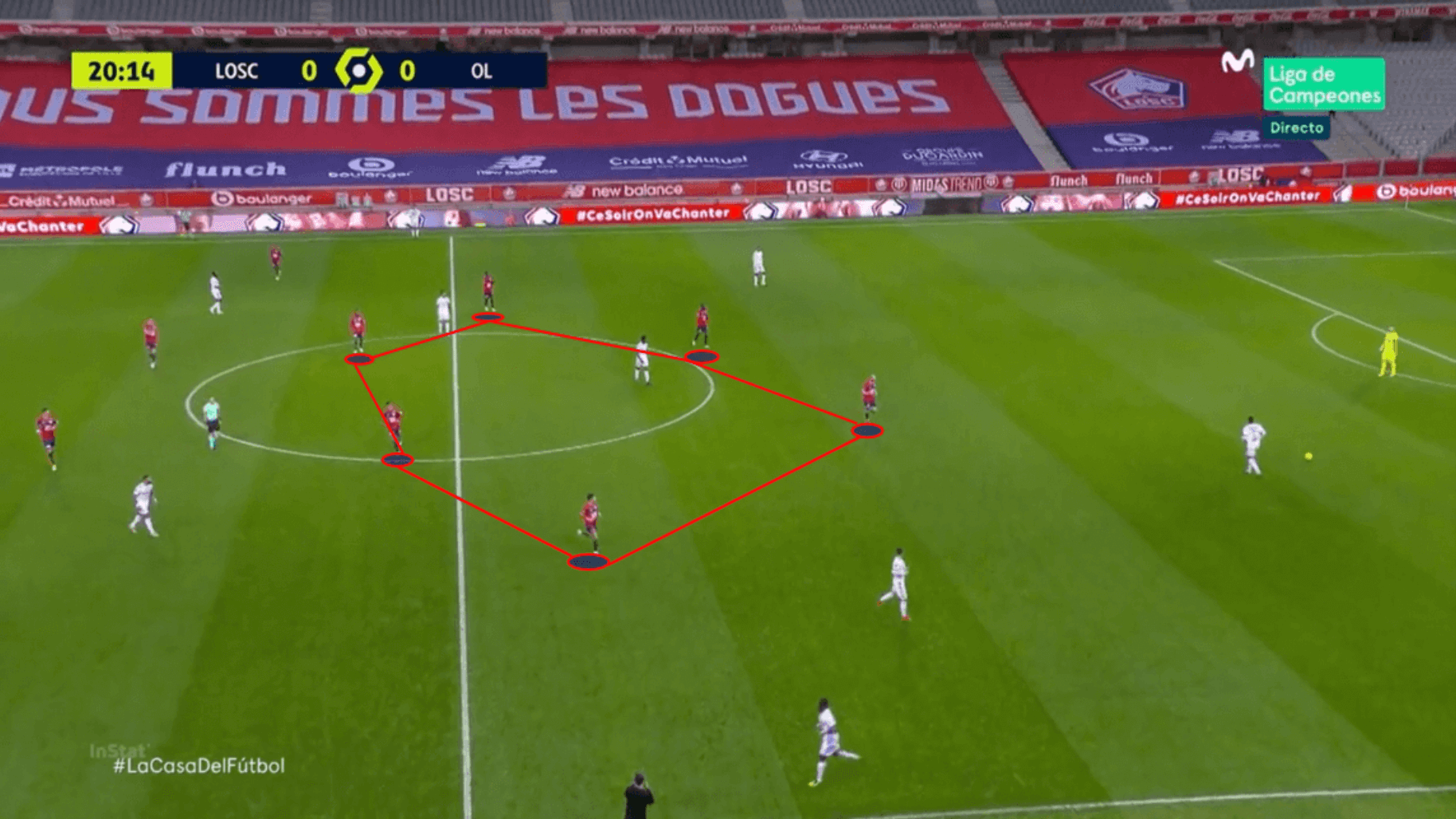
Figure 1 is taken from the reverse of this Sunday’s fixture, which took place back in November and saw both teams settle for a point as they drew 1-1 at Lille’s Stade Pierre Mauroy. Here, we see Lille set up in their typical 4-4-2 mid-block that they’ve utilised consistently throughout the season to great success.
In this system, during the early stages of the opposition’s build-up play, Lille’s centre-forwards tend not to press the opposition centre-backs or goalkeeper. Instead, they cut off the passing lanes between those players and the holding midfielder(s). Meanwhile, Lille’s wingers tend to sit very narrow. This, combined with the centre-forwards’ passive but deliberate and intelligent defensive play along with the disciplined play of the two central midfielders, allows Lille to congest central midfield significantly, overloading this area and essentially making it very difficult, if not impossible, for the opposition to build through the centre.
These tactics were effective against Lyon in November, as they have been versus the majority of teams that Lille have come up against this term. They will deploy similar defensive tactics on Sunday.
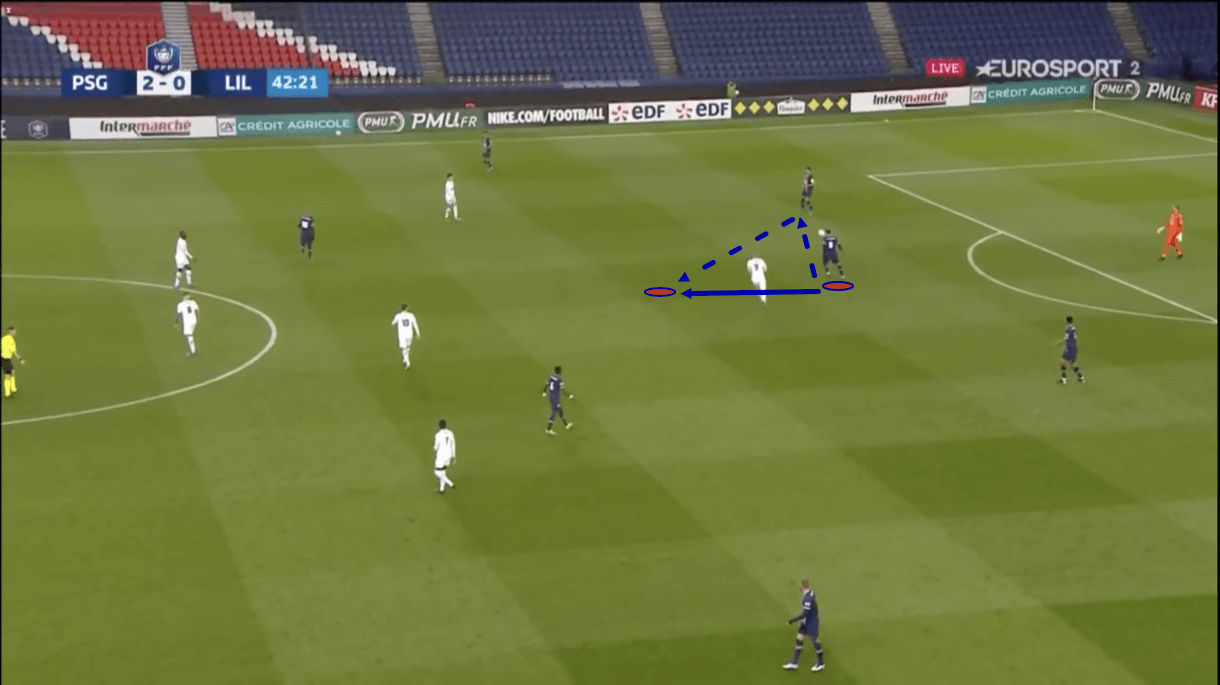
In their 3-0 Coupe de France loss to PSG in March, Les Parisiens did a good job of playing through Lille’s defensive shape, which was actually a 4-2-3-1, rather than a 4-4-2, for this game but this shape also created a six-man central overload. In figure 2, we see an example of one way PSG managed to play through the centre despite Lille’s central overload.
Here, we see that right-sided holding midfielder Leandro Paredes has dropped deep, splitting the centre-backs, with left-sided holding midfielder Idrissa Gueye staying in the midfield line. Paredes poses a great threat from deep thanks to his excellent vision and passing range, so as he dropped deep, he naturally attracted pressure from Lille’s striker, who could no longer block off the passing lane into him by sitting deep and being part of his side’s compact mid-block.
As PSG attracted this pressure through movement and some quick short passes, Paredes and one of PSG’s centre-backs play a quick one-two, with Paredes quickly bursting forward to get around the pressing forward and onto the ball in a more advanced position, taking advantage of the space that’s opened up between the striker and his deeper teammates and ultimately finding himself on the ball in his natural right-sided holding midfielder position, from where he can progress play.
Lyon similarly have some dangerous deep-lying playmakers in their team. Ball-progressors like Thiago Mendes, who we expect to start on Sunday, or Bruno Guimarães can help their side to beat Lille’s press, giving them an easier time than they had back in November. So, we think a key tactical decision for Lyon in this game could be to have one holding midfielder dropping deep and performing a similar role to the one Paredes performed when his side overcame Lille in the Coupe de France just over a month ago.
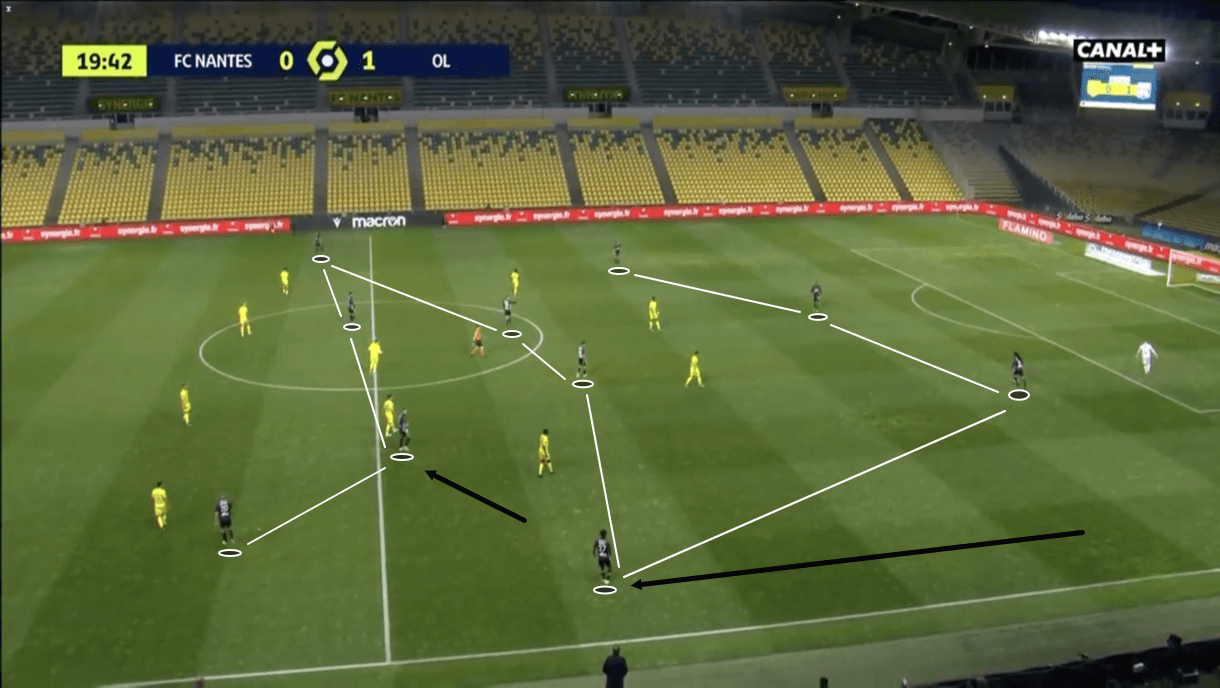
Lyon do tend to build with a three-man backline, as figure 3 demonstrates, where one full-back tucks inside and one full-back pushes forward to provide the width on that wing, allowing the winger to move into the half-space. From their deep position, the full-back who tucks inside tends to perform a key role for Lyon in the build-up too, with left-back Maxwel Cornet and right-back Léo Dubois playing a large portion of Lyon’s progressive passes and long passes this season.
As a result, Les Gones could just attempt to outnumber Lille’s two pressing forwards with their regular three-man backline, leaving the holding midfielders in the middle of Lille’s hexagon and hoping that they can force passes through the lines despite Lille’s press.
However, these full-backs will still be in a somewhat wide position, they will find it difficult to play the ball into central midfield with the Lille strikers’ positioning and they could find themselves as the target of an aggressive version of Lille’s pressing. At times, Lille do press very aggressively, and do so effectively.
One scenario where Lille’s press becomes more aggressive is when the opposition play a backwards pass. Lille’s players effectively ‘switch on’ when the ball moves backwards and begin hunting the ball. Another scenario where Lille’s press becomes more aggressive is when the ball moves out wide. When full-backs receive the ball, again, Lille’s players effectively ‘switch on’ and press aggressively. This is because these players have less space than central players, due to the sideline being right beside them, limiting where they can play to.
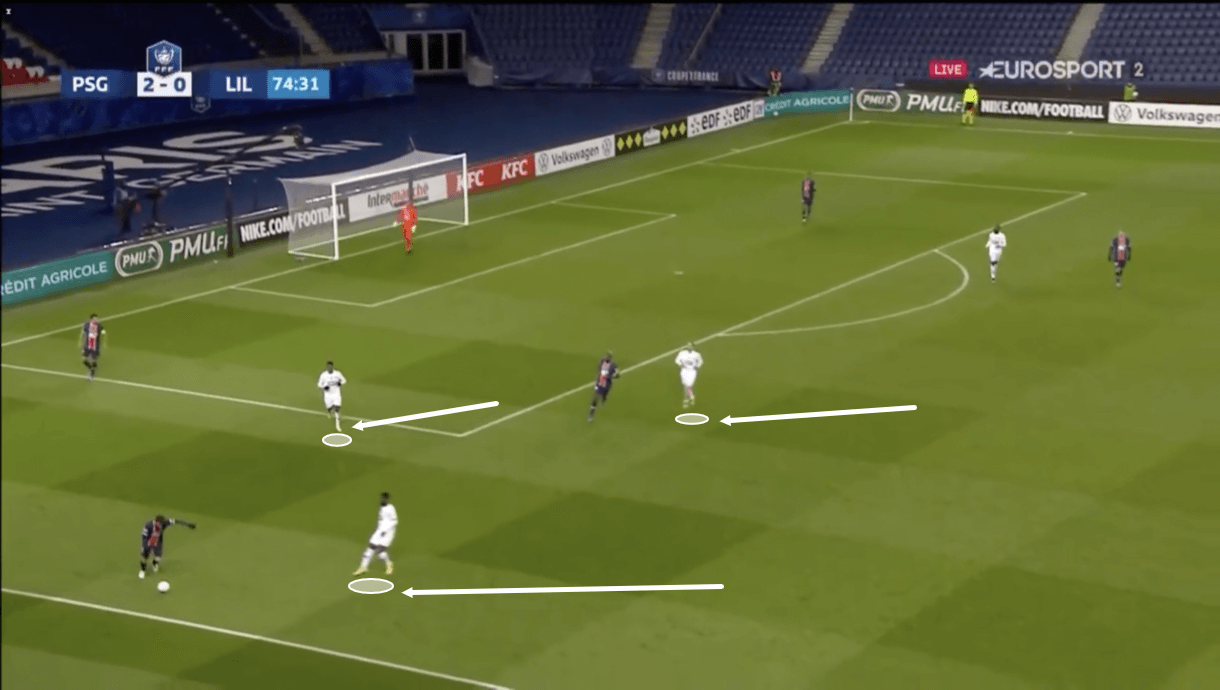
We can see an example of this in Figure 4, where Lille’s winger and two strikers have pressed aggressively as the opposition full-back receives the ball. Usually, Lille’s near-side full-back will press aggressively here too, probably marking the opposition winger, and the two central midfielders will also typically shift over towards this wing to offer support and further congest the area. This press tends to cut off all the near passing options, making it difficult for the opposition to play out.
As a result, if Lyon do intend to rely on their full-backs during build-up, it could prove costly, as all it will take is one mistake to be forced by Lille’s aggressive pressing in this area for Lyon to give away a great counterattacking opportunity to Lille in a very dangerous position. Lyon may be prepared for this and have a plan set up to use the full-back to bait the press and play around it, but there’s a reason why this press has been so effective this term and in such a crucial game, it’s probably not the time to experiment too much, so the best bet for Lyon to play through the thirds and beat Lille’s press may be to use a holding midfielder deep, in a similar role to the one we saw Paredes play.
Meanwhile, Lille’s pressing can set up very dangerous counterattacking opportunities, as mentioned, so they will be waiting like vultures for any mistakes that Lyon make during this phase, especially in the full-back areas, to pounce and spring a counter. Both sides will view this particular stage of play as a potential difference-maker and will be keen to win this key battle.
Lille’s build-up vs Lyon’s pressing
We’ll see another key battle at the other end of the pitch, as Lille’s build-up play meets Lyon’s pressing. The aggressiveness of Lyon’s pressing doesn’t differ greatly from the aggressiveness of Lille’s pressing. Lyon have a PPDA of 11.75, on average, in Ligue 1 this term. This is just 0.03 lower than Lille’s PPDA, placing them in sixth in France’s top-flight, with just five teams pressing more aggressively than them this term.
Despite the two teams’ extremely similar PPDAs, we expect to see Lyon try and force turnovers in advanced positions more often than Lille in Sunday’s fixture, though this game will, likely, be quite a cagey affair overall, with both teams sure to focus primarily on minimising their errors and capitalising on their opponents’.
Lyon usually play in a 4-3-3, with the attacking trio of Memphis Depay, Karl Toko Ekambi and Tino Kadewere having made a big impact in Ligue 1 this season. However, Kadewere has been absent through injury in recent weeks and this has seen Lyon switch to playing with a 4-2-3-1, with Islam Slimani taking Depay’s place centrally, Depay moving out to the left, Toko Ekambi moving out to the right from the left and usual ‘number 8’ Lucas Paquetá taking on the ‘number 10’ role.
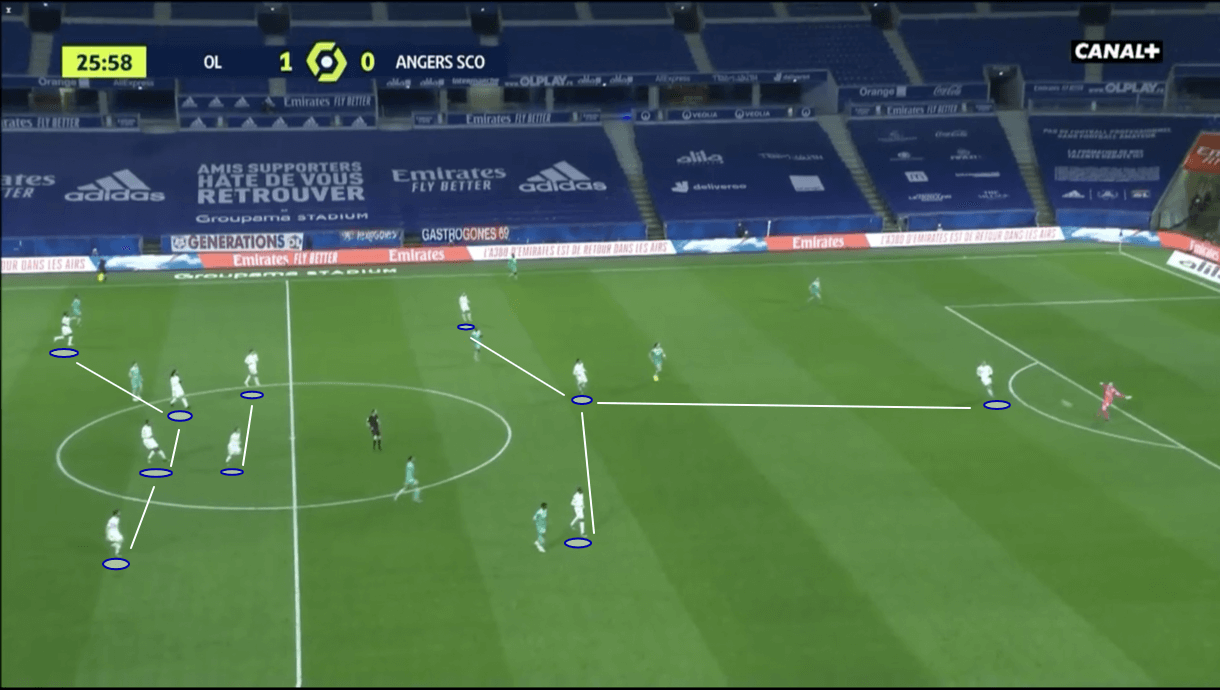
Figure 5 shows Lyon defending in their 4-2-3-1 shape during their recent 3-0 win over Angers. Whether or not they continue playing with a 4-2-3-1 or switch back to a 4-3-3 for Sunday’s fixture could depend on the fitness of Kadewere. Usually, Depay plays centrally as a ‘false 9’ but in Kadewere’s absence, Slimani fulfils the role of a more traditional ‘number 9’, allowing room for Paquetá to play the ‘10’ role in between the lines in possession, which Depay normally plays.
However, defensively, there isn’t a massive difference between Lyon’s shape in the 4-2-3-1 and the 4-3-3, as when they play in a 4-3-3, one central midfielder, usually Houssem Aouar if he’s playing, tends to advance into the ‘number 10’ position, or even into the forward line alongside striker Depay, resulting in something closer to a 4-2-3-1 or 4-4-2 shape being formed, rather than a 4-3-3. Similar to Lille, Lyon place a great emphasis on avoiding being overloaded centrally when they defend.
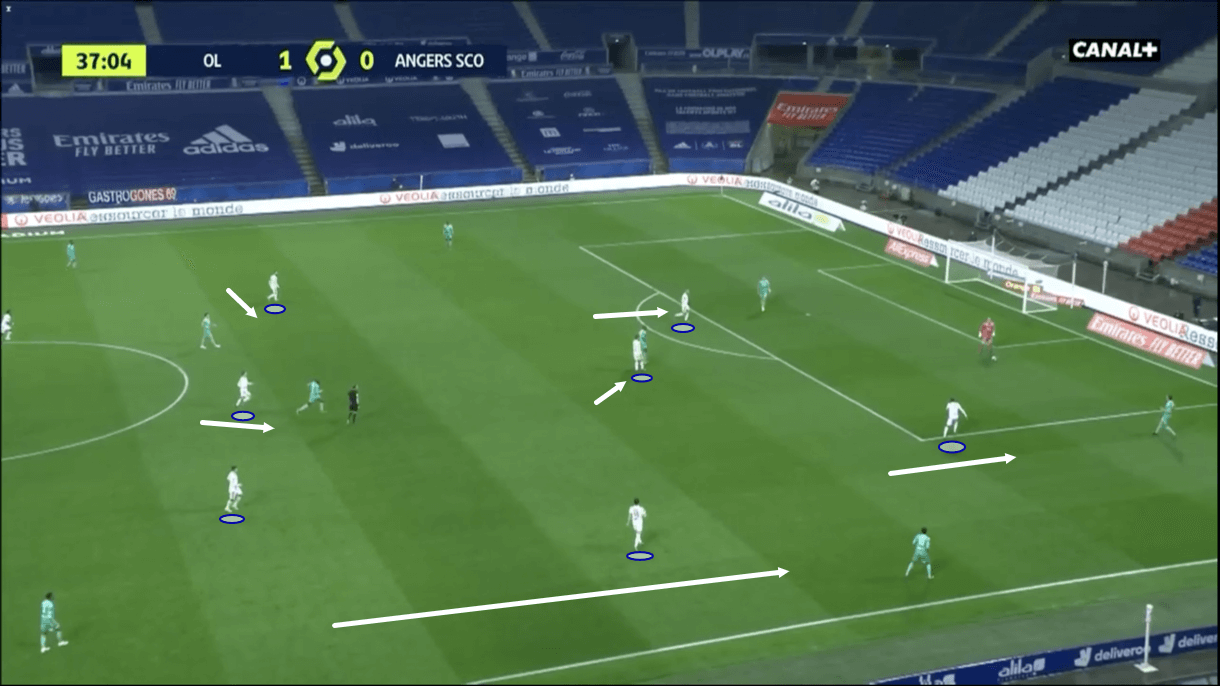
During the early stages of the opposition’s build-up, Lyon tend to press the opposition’s backline more aggressively than Lille generally do. Their centre-forward, be it Depay or Slimani, leads the press and will typically aim to force the opposition to play from the centre out to the left or right wing. When they succeed in forcing the opposition into a wider position, then the team’s press picks up a notch in aggression, with more players committing to an advanced position, as we see in figure 6.
Here, the striker is seen centrally, nearest to the right centre-back who had been on the ball just before this image. The ‘10’ can be seen just behind him, marking the opposition’s holding midfielder, while the ball-near winger presses the left centre-back and the ball-far winger stays deeper, offering support to the central midfielders. Additionally, Lyon’s right-back gets forward to mark the opposition’s left-back.
As a result, Lyon get into a good position to prevent the opposition from building out safely from the back, forcing them to either play the ball long – a risky pass that could allow Lyon to regain possession in a deeper area, play the ball to a man being closely marked – a risky pass that could allow Lyon to regain possession in a dangerous, advanced area, or hold onto the ball and risk attracting more pressure and being dispossessed themselves. This is the kind of scenario that Lyon will attempt to set up for Lille during the league leaders’ build-up play on Sunday.
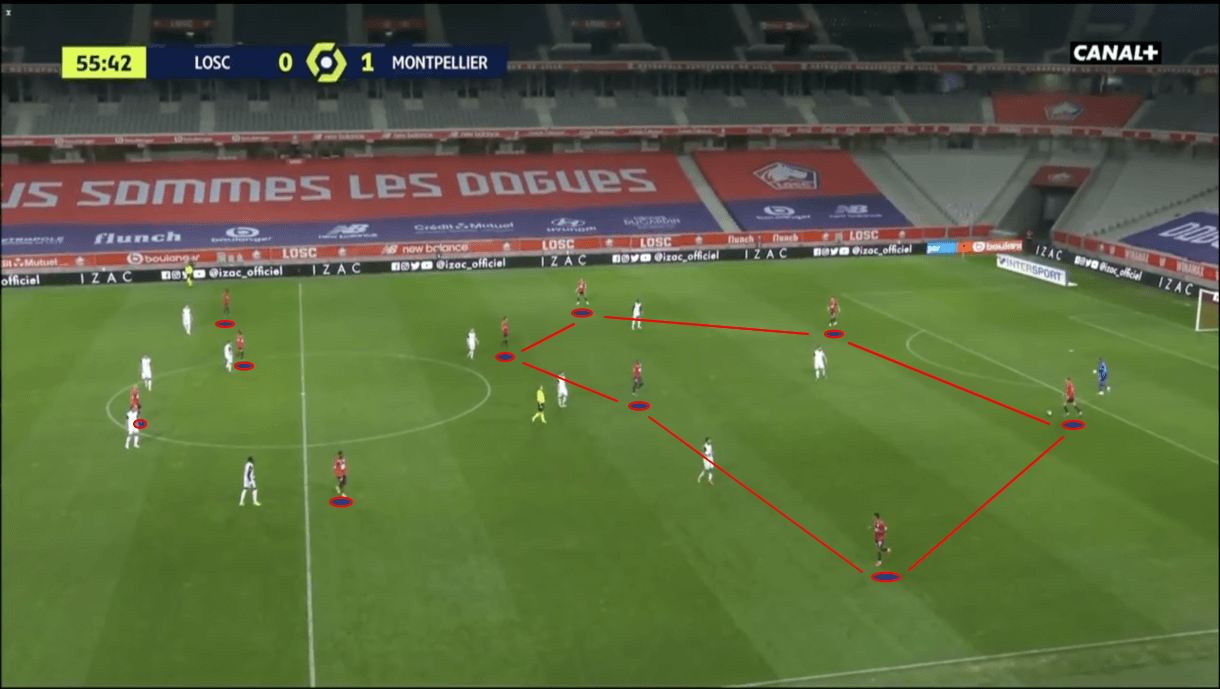
As for the early stage of Lille’s build-up play, they will generally line up as they do in figure 7 when playing out from the back. Their central midfield duo, likely to be Benjamin André and Boubakary Soumaré on Sunday, both sit inside their own half, as the full-backs stay wide, with one preparing to get further forward and the other preparing to get more central and stay deep.
Lille’s shape at this stage won’t be too dissimilar to Lyon’s at the same stage but they are likely to be sitting slightly deeper, potentially inviting pressure from Lyon to create space further up the pitch, and they’re likely to play a lot more long balls than Lyon. While Lyon will look to play through the thirds fairly strictly, Lille are much happier to play more directly. Expect to see left centre-back Sven Botman, right-back Mehmet Zeki Çelik, left-back Reinildo Mandava and central midfielder Soumaré playing a key role in ball progression via long passes from deep for Lille in this one.
They will look to use these long passes to beat Lyon’s press and they’ll use Burak Yılmaz as a target man due to his physicality, aerial ability and technical ability to be on the receiving end of these passes, winning flick-ons or knockdowns for his teammates as well as holding up the play. His ability as a target man, along with the deep-lying playmakers’ passing quality, will be key for Lille if they are to beat Lyon’s press and succeed with their build-up play.
Lille’s offence
We already provided some brief analysis of what Lille will look to do in the opposition’s half and beyond in the previous section, but this section will take a deeper dive into what will likely be some key aspects of Lille’s offensive tactics on Sunday.
Firstly, as mentioned previously, Yılmaz will play a key role as a target man for the backline and holding midfielders to aim for with their long balls in this crucial title race clash. His movement, positioning, size and quality of hold up play will all be important for him to play this role effectively.
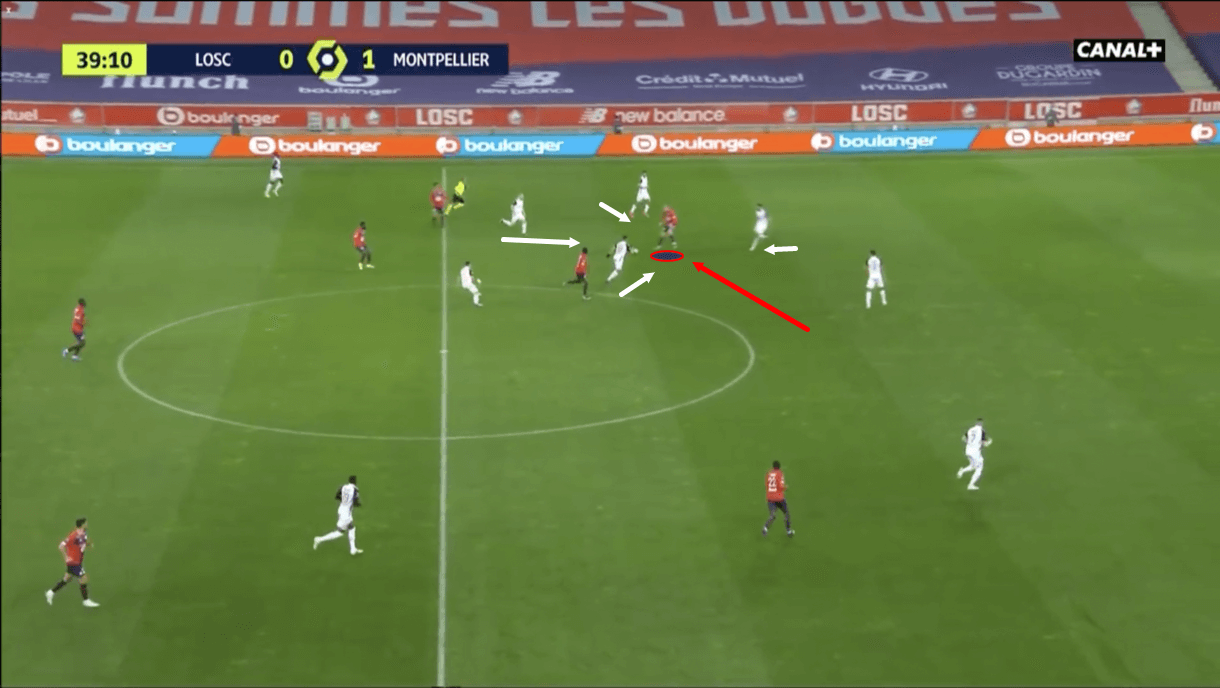
Evidently, one key aspect of Yılmaz’s role will be to free himself up for the deeper players to find him with their long balls. This is where the 35-year-old forward’s intelligent movement and positioning will come into play. In figure 8, we see an example of one occasion where Yılmaz shifted out to the left slightly from his central position to get into a better position to receive the ball from the left centre-back.
Lille will make use of Yılmaz’s technical ability, as well as his size and strength by playing the ball into his feet, with his back to goal, and having him hold off challenges from opposition players while keeping the ball under control. This is a very common role for the striker to play in this system, and one that he played in the reverse of this fixture at Stade Pierre Mauroy back in November. Yılmaz managed to pick up an assist in that game thanks to his ability to trap a ball at speed, hold off opposition challenges with his strength and play a good layoff to a teammate.
As a result of the success Yılmaz has enjoyed playing this role in the 2020/21 season, as well as the fact that Lyon found it difficult to deal with the target man last time around, we’ll likely see Lille use him like this again on Sunday, so expect to see Yılmaz playing with his back to goal a lot, receiving plenty of long balls, contesting plenty of aerial duels, engaging in lots of physical battles with Lyon’s defenders and linking up with deeper players a lot on Sunday.
Another aspect of Yılmaz’s role which is worth mentioning, and is visible in figure 8, is the fact that he can attract pressure from multiple opposition players when holding up the ball, thus creating space for teammates to exploit around him. This was another factor that played a key part in his assist in the reverse of this fixture earlier this season and Lille will attempt to exploit this again on Sunday, with players running off Yılmaz and into the space around him when he receives the ball.
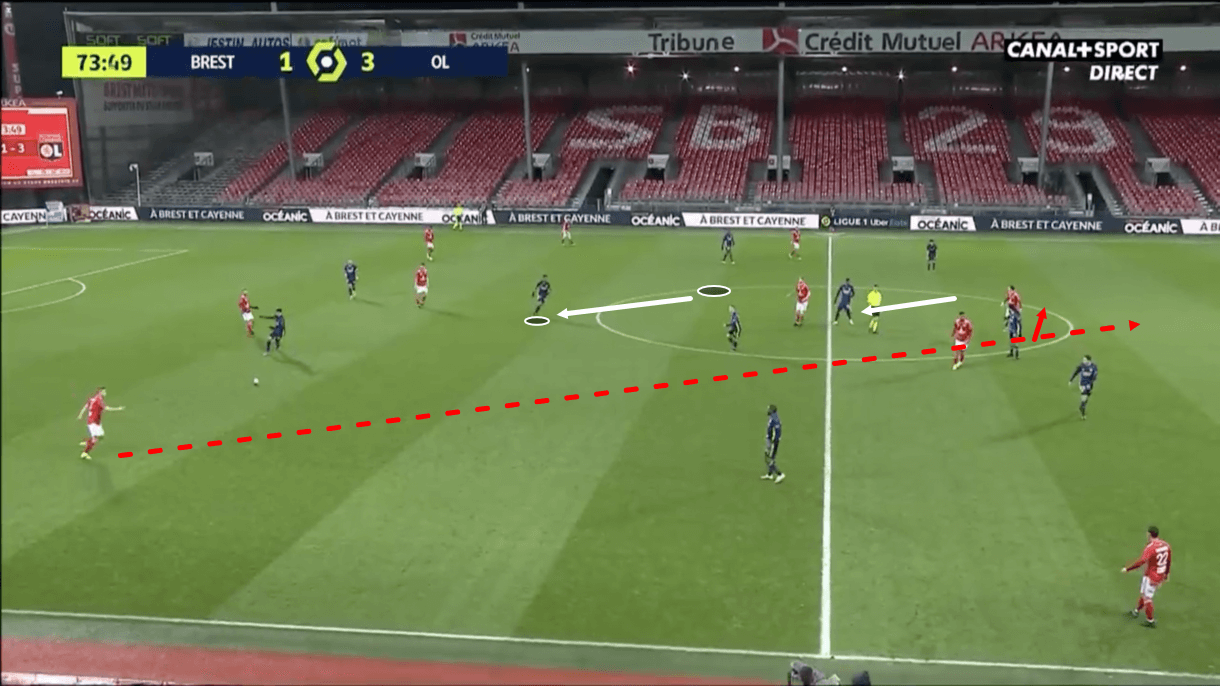
One area where Lyon can be exploited is via long balls over the top to pacey runners in behind. As we saw in the previous section, Lyon’s backline tends to sit quite high while the more advanced players press aggressively and this can be exploited, as Brest did earlier on this season in figure 9 above.
Here, Brest took advantage of Lyon’s pressing tactics masterfully. Just before this image, Lyon’s right-sided holding midfielder was dragged upfield by an opposition midfielder who dropped deep to provide support. As this holding midfielder was drawn upfield, Brest’s right forward here dropped into the space he vacated, leading to Lyon’s right centre-back being dragged out of position. This created room for Brest’s centre-forward to drift into and as play moves on here, he does that as the centre-back on the ball picks him out with a long ball over the top that plays him through on goal.
This is just one example of how Lyon’s backline can be exploited with long-balls over the top when they’re pressing aggressively from the front – there have been numerous occasions this term where Lyon have conceded goals from chances resulting from long through balls over the top and this is a blatant area for Lille to try and exploit on Sunday, especially when they play plenty of long balls anyway and they’ve got players like Botman, Çelik, Soumaré and Reinildo to play them. Additionally, Lille have plenty of quick attackers like Jonathan David – who may be fit for Sunday – and Jonathan Bamba to run in behind and get onto the end of those long balls.
Expect Lille to sit deeper than Lyon in the early stages of build-up to attract pressure. This will, in turn, attract their backline further up the pitch, and with well-documented issues of defending against long balls over the top for pacey attackers, as well as Lille’s well-documented fondness for playing long balls, expect Les Dogues to make exploiting this weakness in Lyon’s game a key part of their tactics this weekend.
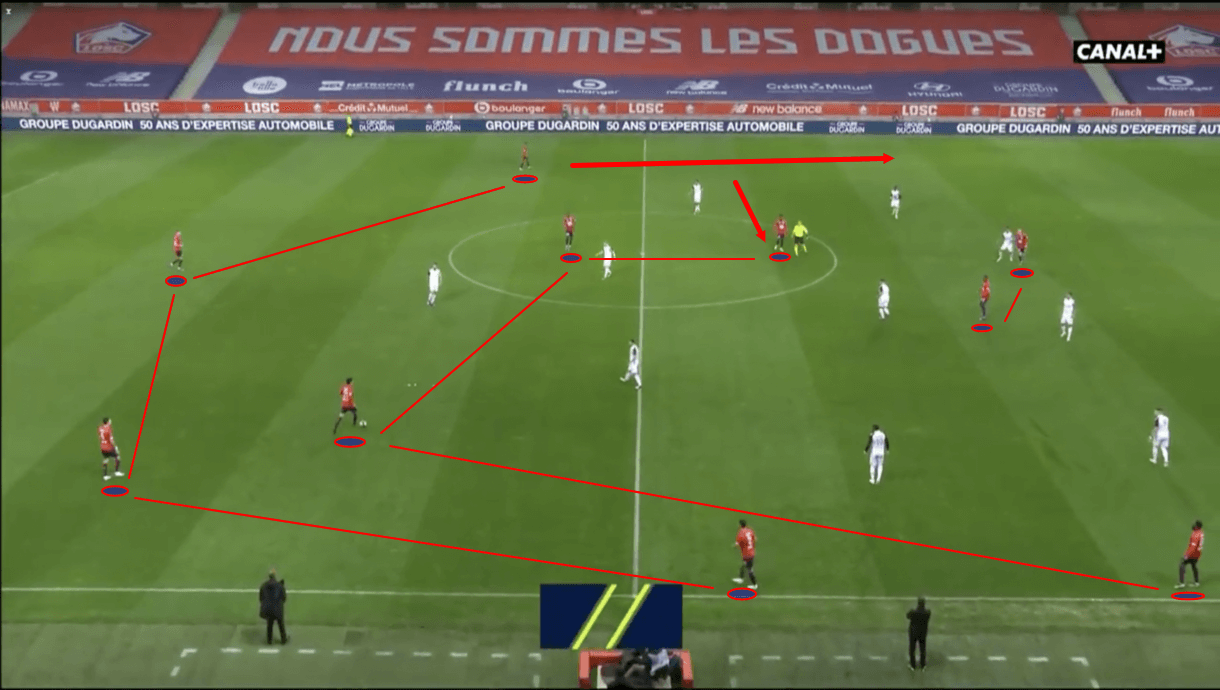
In figure 10, we see Lille’s offensive shape at a slightly more advanced stage of the attack than we saw it in figure 7. Just before this image, right-back Çelik had advanced forward, with left-back Reinildo tucking in deep, forming a three-man backline alongside the two centre-backs. However, as play moves on here, the right-back retreats, joining the backline while the left-back ventures forward.
We can see that Lille’s left-winger has drifted into the half-space, creating space out wide for the overlapping left-back to push into. This is a very common sight in Lille games. One full-back, but not both full-backs, will always be charging forward. They work together very effectively in this regard – with this providing an example of how Galtier has conveyed his ideas and implemented them effectively with this Lille squad.
We can expect to see Lille playing in a 3-2-5 shape in attack, with the full-backs alternating between which one stays back and which one goes forward. As the full-back goes forward, the winger on that side pushes into the half-space and Lille create a five-man front line which can overload the opposition’s backline. At this point, Lille will look to get the ball into the frontline to take advantage of their overload if it is, indeed, present.
Lyon’s offence
Similar to the previous section, this final section provides analysis of some key tactics that we anticipate Lyon will be most likely to use inside the opposition’s half and final third, on the ball, in this significant fixture.
As mentioned before, Kadewere’s fitness will play a key part in determining how Lyon are most likely to shape up, and as a result, attack the opposition on Sunday. If the Zimbabwean is deemed fit to start, then a return to the 4-3-3 that served Lyon so well earlier this season is likely to be on the cards but if Kadewere isn’t starting and Slimani is in his place, as he has been in recent weeks, then perhaps it’s more likely we’ll see Lyon stick with the 4-2-3-1 that they’ve used in Kadewere’s absence of late.
Regardless of which exact shape they line up with and how exactly they go about achieving their aims in attack, however, there are some constant principles of Les Gones’ offensive tactics that we expect to see on Sunday.
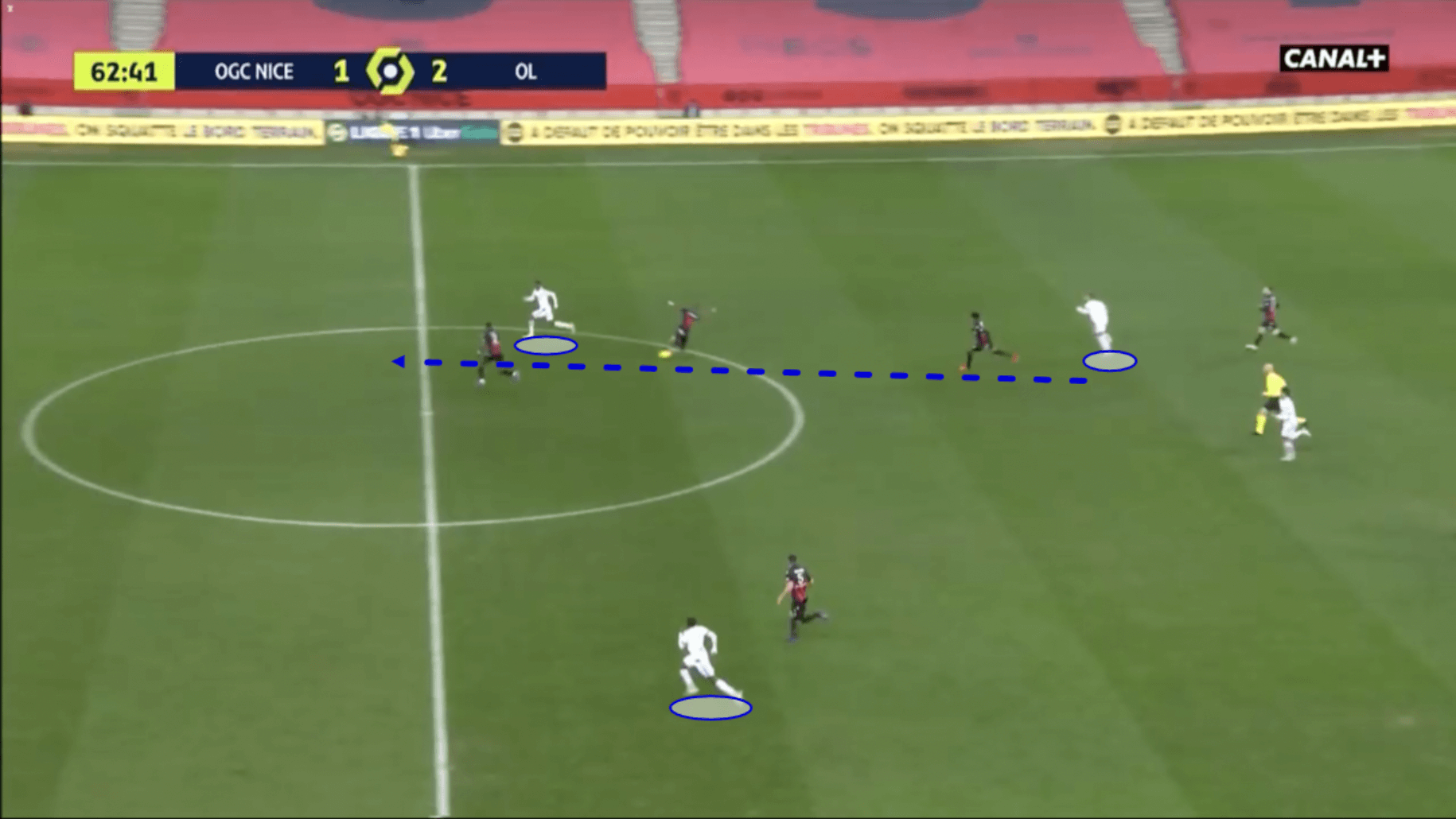
Firstly, in figure 11, we see Lyon playing in a 4-3-3, with ‘false 9’ Depay creating space for the inside forwards, Kadewere and Toko Ekambi, to exploit via their runs inside. Just before this image, Depay dropped deep from his centre-forward position to become the creator in this ‘false 9’ role, as he has a lot of the time this season.
A key part of Depay’s role here, in addition to playing the through ball to the inside forwards, is his movement from the advanced centre-forward position to this deeper position in between the lines where he drifts around to find space where he can become a progressive passing option for the deeper players and ultimately become the playmaker for his side.
This is typical of Depay’s role in Rudi Garcia’s side this season and if Kadewere is fit and Lyon do play in a 4-3-3 on Sunday, then expect to see plenty of Depay dropping off like this, looking for space in between the lines to become a progressive passing option before playing the through ball to the inside forwards ahead of him.
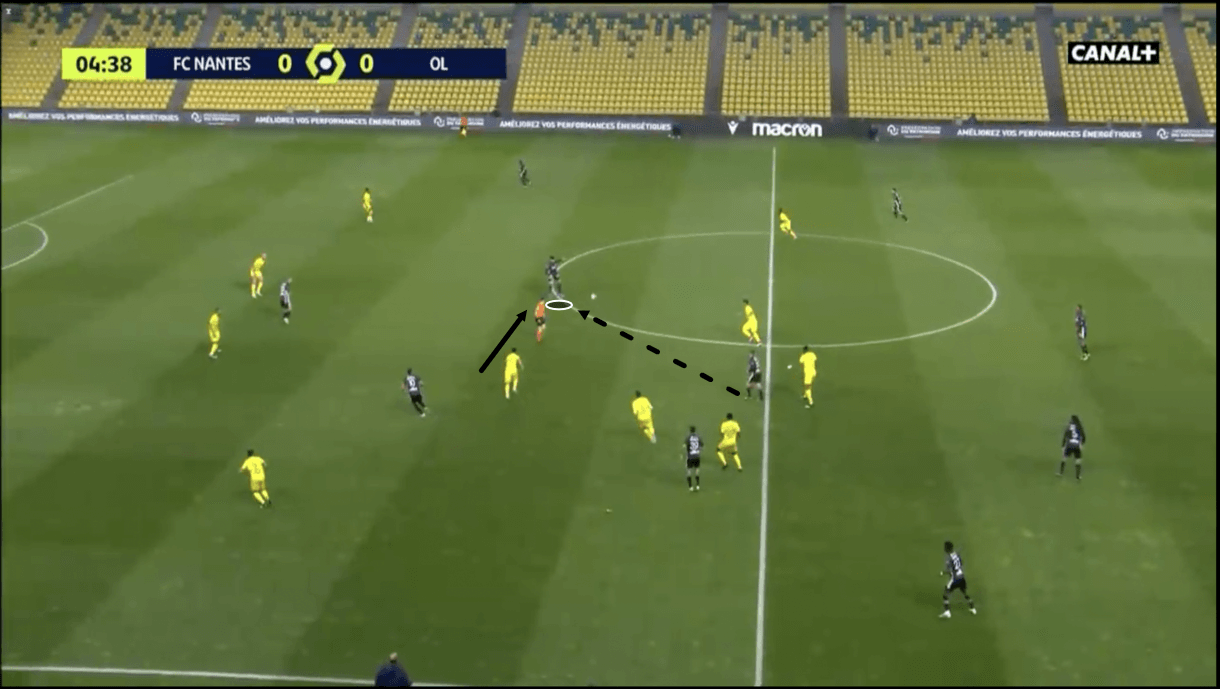
However, if Kadewere is unfit to start and Lyon end up sticking with the 4-2-3-1, then the ‘10’ – who will likely be Paquetá – will perform Depay’s role of drifting around in between the lines to find space and become a progressive passing option before playing a through ball to the runners ahead of him, as was the case in figure 12.
Paquetá is excellent at finding space in between the lines. Even when playing as an ‘8’, rather than a ‘10’, this tends to be a key part of his game. He is great at becoming a progressive passing option for his deeper-lying teammates because of his ability to spot space and drift away from markers without them noticing. Paquetá’s movement is excellent in these areas.
Paquetá is also very good at receiving the ball on the half-turn before utilising his technical ability to play through balls to the runners ahead of him, in this case above, Slimani, Depay and Toko Ekambi in figure 12.
So, if Lyon play with a 4-2-3-1 due to Kadewere still being unfit to start, expect Paquetá to perform the ‘Depay-role’, drifting around in between the lines creating chances for the runners ahead.
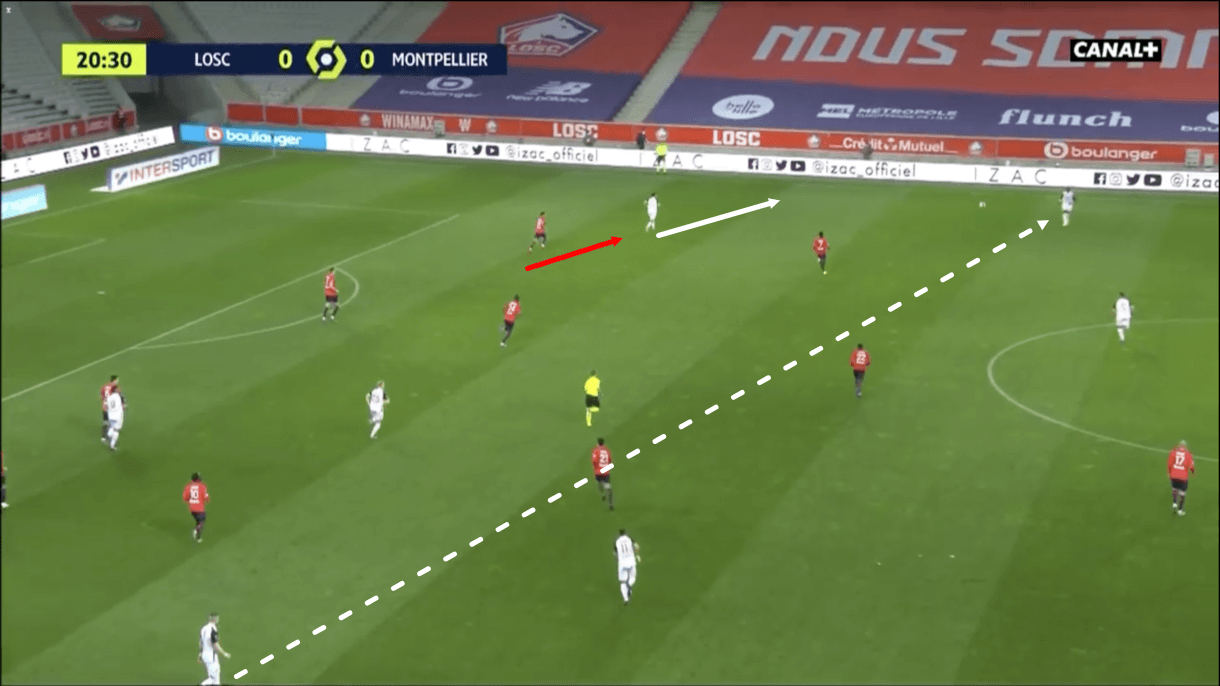
As mentioned, Lille have the best defensive record in terms of goals conceded in Ligue 1 at present, so they haven’t demonstrated a lot of defensive weaknesses this term. However, they have conceded a few goals resulting from scenarios like the one we’re going to analyse in figure 13.
Here, we see Lille’s opponents, Montpellier, in possession of the ball on the right-wing, with the right-back having just received a crossfield pass from the opposite wing. Meanwhile, the right-winger is drifting out wide to offer support to the man on the ball, along with the right central midfielder and some other teammates trailing behind. As the right-winger pushes out wide, he drags Lille’s left-back out wide with him, while the rest of Lille’s defensive shape also starts to shift over to this wing.
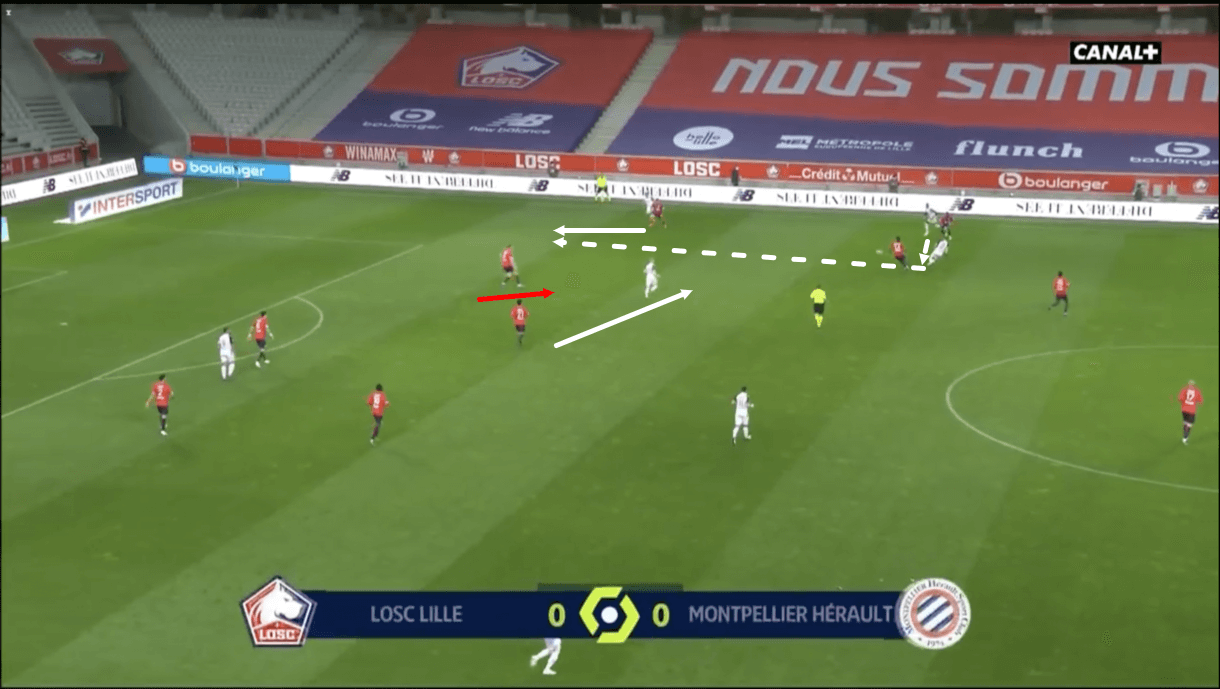
As play moves on, however, in figure 14 we see that the rest of Lille’s team weren’t quick enough to shift over, while the left-back got dragged far out wide, resulting in a lot of space opening up between the left-back and the left centre-back for Lille’s opponent to exploit, which they do, as Montpellier ultimately score a goal from this attack.
This passage of play highlights a potential weakness for Lyon to exploit in Lille’s defensive setup, which is a weakness at defending against quick switches of play. Lille tend to remain very vertically and horizontally compact in defence and when the ball is on one wing, this leaves a lot of space open on the other wing.
So, if Lyon can exploit that space by making some quick switches of play and then playing through the space that opens up between the full-back and the near centre-back, as Montpellier did here, then they could have some luck and with threats like Cornet and Dubois on the field, Lyon have plenty of creativity in wide areas if they can create chances like this.
Conclusion
To conclude our tactical analysis, in the form of a tactical preview, during Lyon’s build-up, Les Gones may be wise to drop a holding midfielder deep to try and play past Lille’s press, while Lille will try to force Lyon to build out via the wings so they can press aggressively and try to force turnovers in dangerous positions, leading to counterattacks.
On the other side, we believe that Lille will place more men deep and build up with slightly more patience, drawing Lyon’s press upfield to create space further up the pitch that they can exploit via long balls. Meanwhile, similar to Lille, Lyon will try to force play into wider areas via their pressure to force turnovers and create dangerous counterattacking scenarios. Lyon’s attackers will also try to exploit space in between the lines and out wide via switches of play to capitalise on a potential area of weakness.



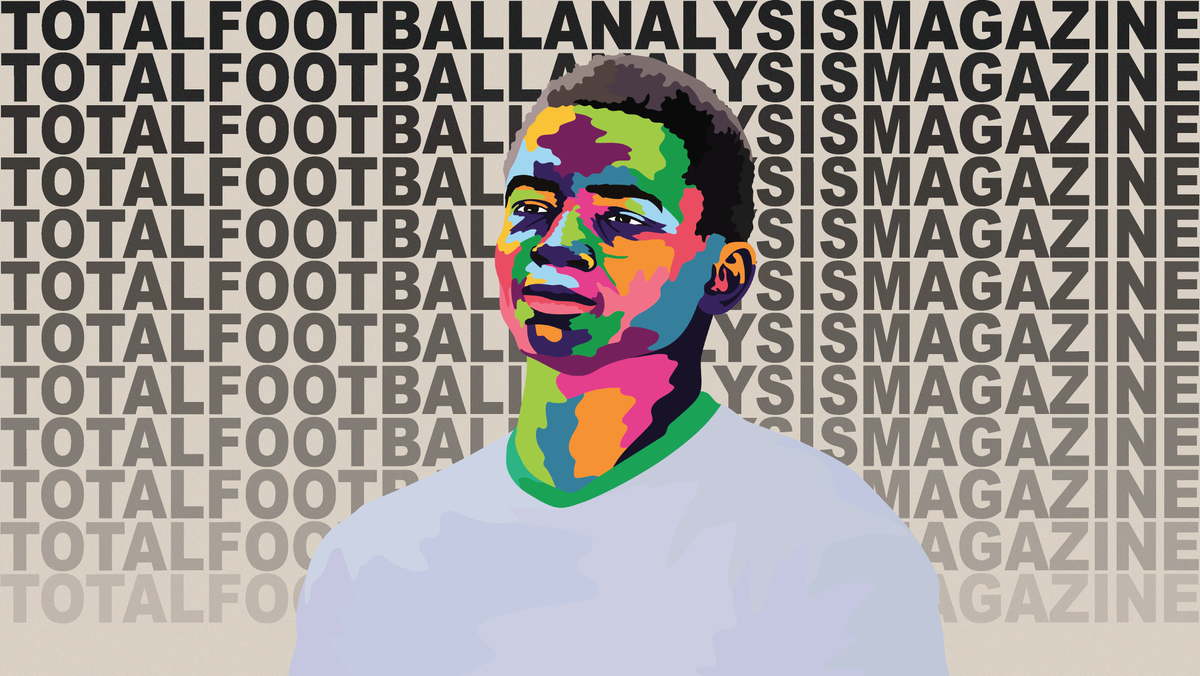

Comments